Fans pay tribute to box-office phenomenon 50 years after his death in Hong Kong
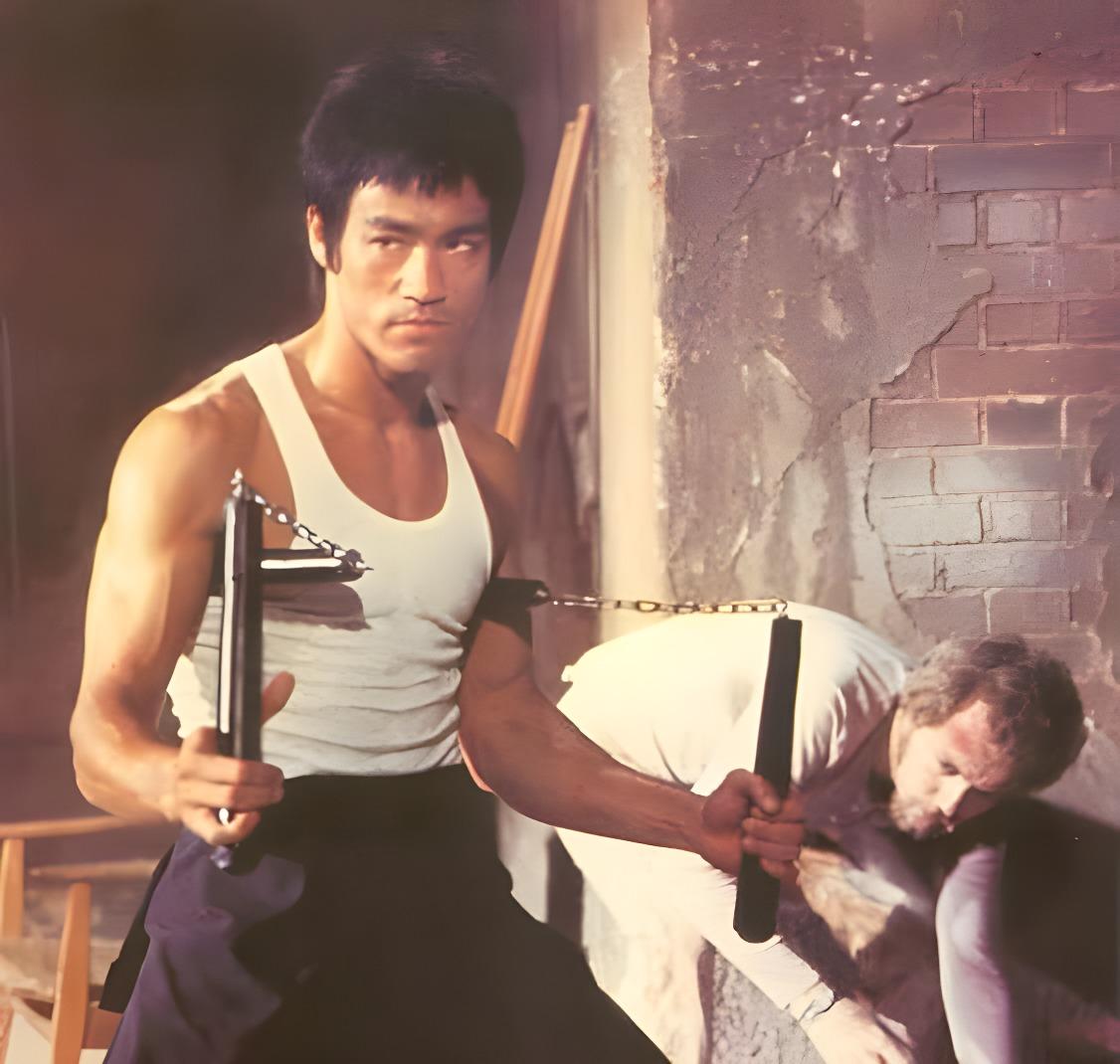 Bruce Lee and Anders Nelsson on the set of Lee's 1972 film The Way of the Dragon. (PHOTO PROVIDED TO CHINA DAILY)
Bruce Lee and Anders Nelsson on the set of Lee's 1972 film The Way of the Dragon. (PHOTO PROVIDED TO CHINA DAILY)
By the end of this year, fans of movie star and kung fu master Bruce Lee, who died 50 years ago in Hong Kong, will be able to visit a virtual replica of his former mansion in the city.
Virtual reality headsets will enable fans from across the world to get a close look at their idol's home and daily life, including the serene courtyard at the mansion and the cherished Mercedes-Benz owned by Lee, which bore the license plate AX6521.
He was at least 30 years ahead of his time, and his visionary mindset earned him the title of ‘the father of MMA (Mixed Martial Arts)’.
Wong Yiu-keung, chairman of the Bruce Lee Club in Hong Kong
Lee, who was born on Nov 27, 1940, is renowned for his martial arts prowess and artistic achievements. He popularized the term "kung fu" to the extent that it became a Chinese cultural symbol globally.
Born in San Francisco and raised in Hong Kong, he bridged the gap between East and West, learning martial arts while immersing himself in philosophy.
Lee, 32, died from cerebral edema, or swelling of the brain, on July 20, 1973.
His spirit continues to resonate with admirers worldwide, including Wong Yiukeung, who is in his 50s and has been a Lee fan for about 40 years. Wong is responsible for the virtual revival of Lee's Hong Kong mansion at 41 Cumberland Road, Kowloon Tong, which was demolished in 2019.
At primary school, Wong read magazines that featured Lee's kung fu skills. He was immediately drawn to the star and started to imitate him.
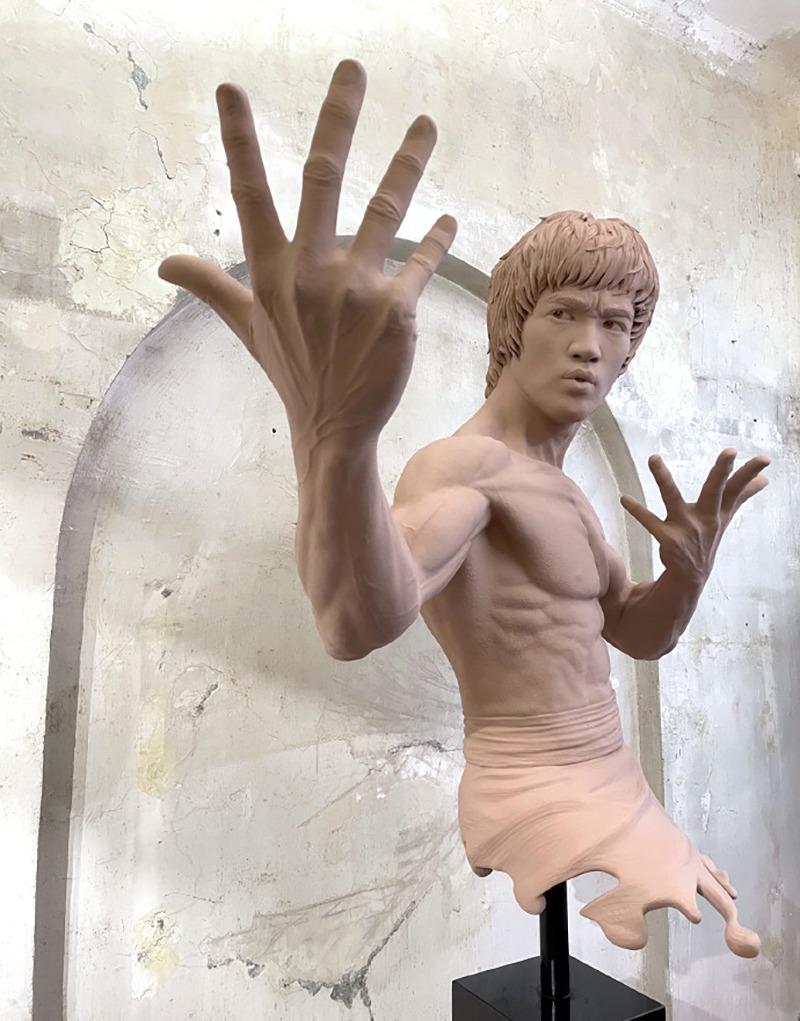 A bust of Bruce Lee made by Ma Fu-keung. (PHOTO PROVIDED TO CHINA DAILY)
A bust of Bruce Lee made by Ma Fu-keung. (PHOTO PROVIDED TO CHINA DAILY)
As a teenager, Wong repeatedly watched films and television programs that featured Lee. In the 1990s, when Wong was in his 20s, he placed an advertisement in a magazine to seek Lee collectibles, but instead of being offered items, he received numerous replies from people hoping to get their hands on such collectibles.
Sensing this large fan base, the magazine's editor-in-chief established the Bruce Lee Club, which within weeks boasted hundreds of members. Responsibility for organizing the club was handed to Wong, who became its chairman.
In 2004, when the Avenue of Stars opened in Tsim Sha Tsui, Hong Kong, as a new attraction, Wong wrote to its management several times, suggesting that a bronze statue of Lee be built on the site. After this idea was approved, he spent several months persuading friends and celebrities to give donations. Some HK$800,000 ($102,240) was received and the statue was completed in nine months.
Four years later, when it was announced that Lee's former mansion was to be sold by the owner, a business tycoon, Wong wrote to the Hong Kong government and the owner, calling for the property to be preserved.
Over the next 11 years, Wong lobbied stakeholders, proposing ideas such as transforming the residence into a Bruce Lee museum. However, in 2019, due to conflicts of interest, collaboration between the owner and the government ended, and the property was demolished.
In 2019, Wong decided to digitally reconstruct the residence to safeguard its legacy indefinitely in the virtual world. After four years of work, he is ready to launch the project in November.
Wong has more than 3,000 items of Lee memorabilia, including videotapes, books, DVDs, clothing, tiles from the star's former residence, and even slot machines from Japan adorned with Lee's image. "If I had enough space at home and at the club, I would buy more," Wong said.
Wong's club, which boasts more than 600 members, has organized some 70 commemorative events.
Key landmark
On July 20, the 50th anniversary of Lee's death, Wong placed flowers in front of the actor's statue on the Avenue of Stars, tears streaming down his cheeks. He stood for a long time and watched fans from around the world pay respects to their idol.
The statue has become one of Hong Kong's most significant landmarks. "It is a testament to the enduring love that countless people hold for Bruce", Wong said.
That day, Anders Nelsson was among the fans who laid flowers at the statue.
Born in California, Nelsson moved to Hong Kong at the age of 4. When he was 26, he met Lee by chance in a restaurant, which led to Nelsson playing a thug in Lee's 1972 film The Way of the Dragon. During two days of filming, Nelsson worked closely with the star.
"Even in a crowded room, Bruce stood out," he said, adding that Lee was fearless and not afraid to speak his mind.
Being the film's writer and director, Lee possessed exceptional artistic talent and was in total control of the project. He had a close eye for detail, and everyone on the set followed his direction, Nelsson said.
Lee dedicated himself wholeheartedly to martial arts. He even found ways to challenge himself during breaks in filming by asking workers on the set to hold a soda can up high. He then tried to fly-kick it, practicing the move repeatedly until he was successful.
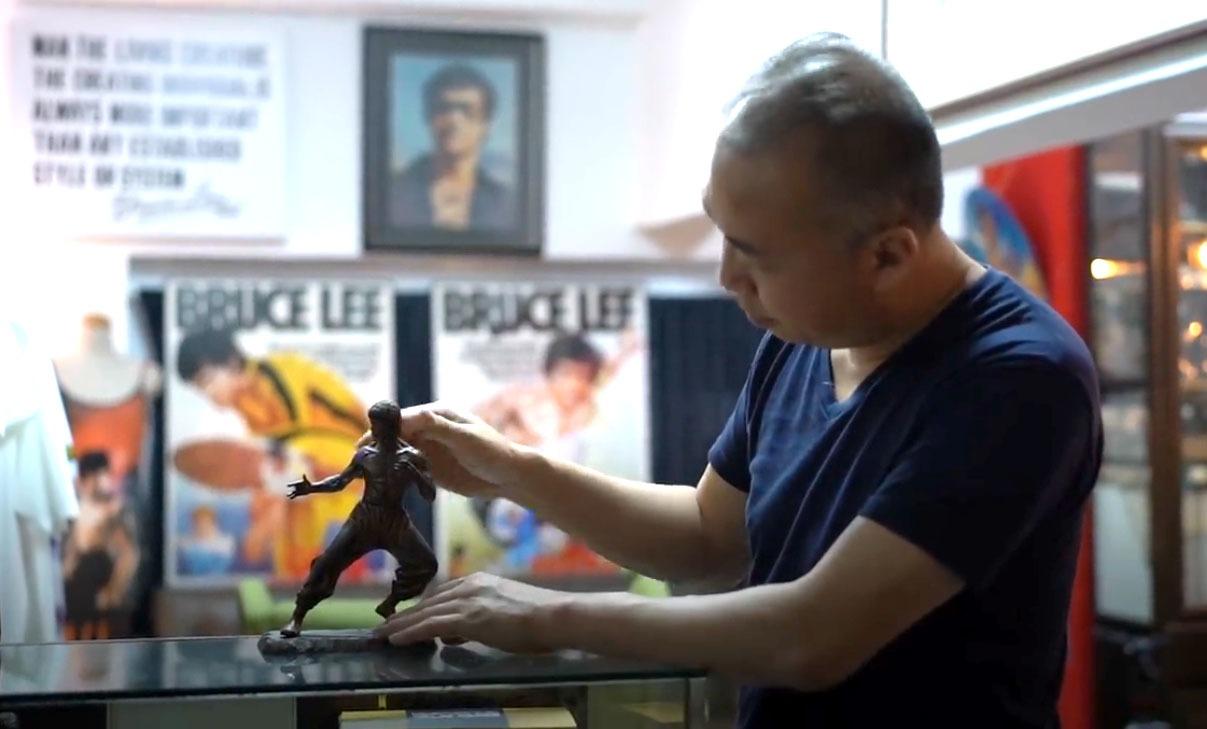 Wong Yiu-keung, chairman of the Bruce Lee Club in Hong Kong. (PHOTO PROVIDED TO CHINA DAILY)
Wong Yiu-keung, chairman of the Bruce Lee Club in Hong Kong. (PHOTO PROVIDED TO CHINA DAILY)
Nelsson was the only person on the set playing a guitar, which caught Lee's attention.
He approached Nelsson and told him to always stay true to himself. These words inspired Nelsson to pursue his passion enthusiastically, and he became a renowned Hong Kong musician and film score writer, winning for Best Score at the Hong Kong Film Awards in 1986 for the movie Mr Vampire.
Nelsson wept when he read about Lee's death in a newspaper, describing it as a devastating loss for Hong Kong. In the following years, countless journalists and fans approached him, asking him to recall his memories of Lee, even though he only worked with him for two days.
Now in his 70s, Nelsson has told the same story many times. "It's no trouble, but such an honor for me," he said.
Nelsson, who has amassed a collection of materials related to Lee, has also created a Facebook page called Bruce Lee & Anders Nelsson to document his interactions with the performer. He often strolls along the Avenue of Stars to visit Lee's statue.
On the anniversary of Lee's death, some fans presented handmade artwork in his honor, including paintings. A display of more than 20 portraits themed on Lee adorns the white walls of an art gallery at an exhibition venue in Sham Shui Po, Hong Kong.
Ranging from Lee clad in his classic skintight yellow jumpsuit, to wielding nunchucks — two sticks joined by a length of cord, chain, or hide — or posing bare-chested to show off his physique, each work meticulously captures the kung fu master's presence.
The authenticity of the works is due to 50 years' observation of Lee by their creator, Ma Fu-keung, who is now in his 60s and an acclaimed advertising illustrator with three decades of experience in the industry.
Ma has been a Lee fan since his teenage years. At that time, Ma was skinny and was often bullied, but Lee's films taught him that if a person is strong enough, he or she can protect themself.
Most of Ma's spare time is devoted to creations themed on Lee. In 1998, he made a short animated film about the star, which won an international award. From 2013 to 2021, Ma was invited three times to create short films depicting Lee for exhibitions at the Hong Kong Heritage Museum.
To mark the 50th anniversary of Lee's death, Ma decided to paint by hand. "I wanted to do something special to mark the occasion," he said.
He spent 10 hours each day in his studio, rarely going out. To authentically capture Lee, Ma painstakingly replicated old photographs stroke by stroke, and used different painting techniques for each portrait. This arduous process spanned weeks to several months for each portrait, with the full series taking three years to complete.
Ma's exhibition opened on July 15. The two-week display drew thousands of visitors from around the world, who asked Ma to autograph magazines about Lee.
Commemorations were also held globally to mark the anniversary of Lee's death.
In Los Angeles, more than 200 people gathered to remember the star, while in Sydney, a wreath-laying ceremony was held at a bronze statue of the icon. In Taiwan, many TV stations produced special programs about Lee.
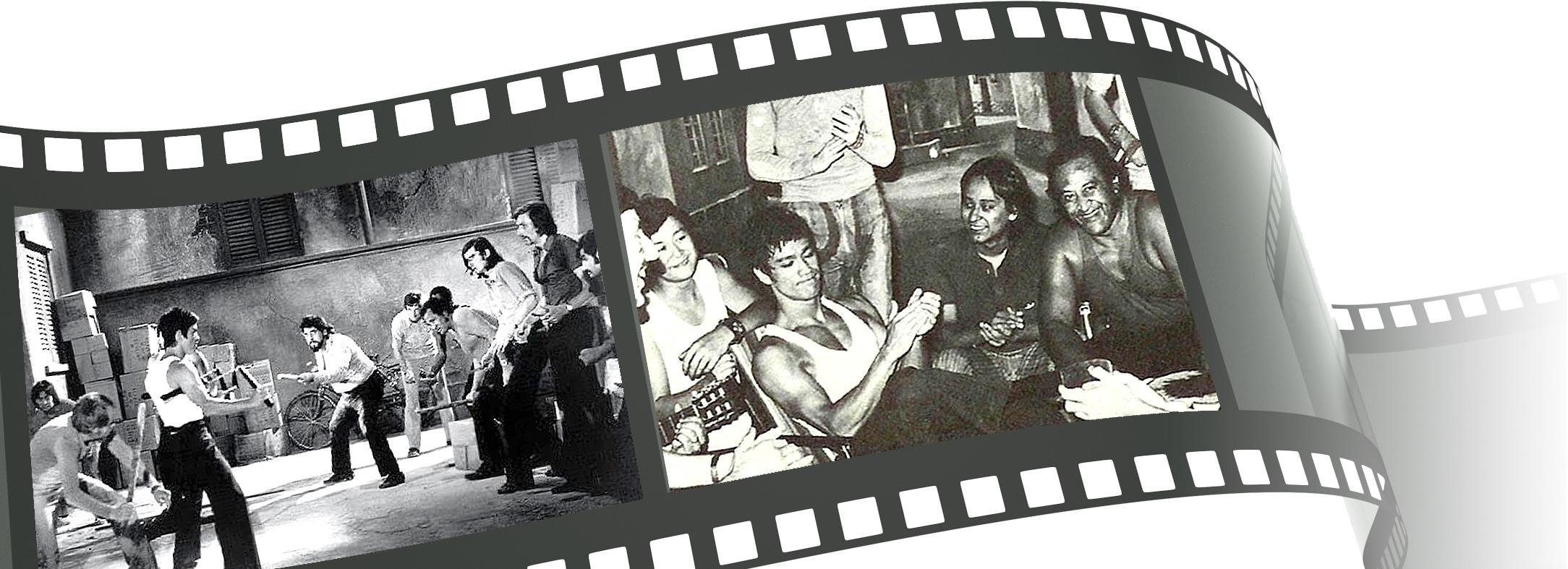 A scene from The Way of the Dragon (left). Lee and other cast members take a break from filming the movie (right). (PHOTO PROVIDED TO CHINA DAILY)
A scene from The Way of the Dragon (left). Lee and other cast members take a break from filming the movie (right). (PHOTO PROVIDED TO CHINA DAILY)
Ahead of his times
As far back as the 1960s, Lee advocated breaking away from the confines of martial arts formalities, and this concept laid the groundwork for Mixed Martial Arts, or MMA, a sport that was formalized in the 1990s.
Wong, who has restored the Lee mansion digitally, said, "He was at least 30 years ahead of his time, and his visionary mindset earned him the title of 'the father of MMA'."
By combining martial arts and cinematic art, Lee created the kung fu film genre, altering the course of global cinema. Even now, most kung fu films worldwide carry the genetic imprint of Lee's works, Wong said.
Mathias Woo Yan-wai, a cultural critic and executive director of Zuni Icosahedron, an international experimental theatre company based in Hong Kong, said Lee was the first to significantly popularize martial arts in mainstream culture, with his influence extending to art forms beyond the silver screen, including Japanese manga, or comic books, combat sports and games.
Zhang Kemin, 44, a Chinese-Canadian composer and scriptwriter, said Lee was also one of the first to transform global perceptions about the Chinese.
Moving from Beijing to Toronto during childhood, Zhang first encountered Lee's films unexpectedly on a Canadian TV channel that typically broadcast only Hollywood classics.
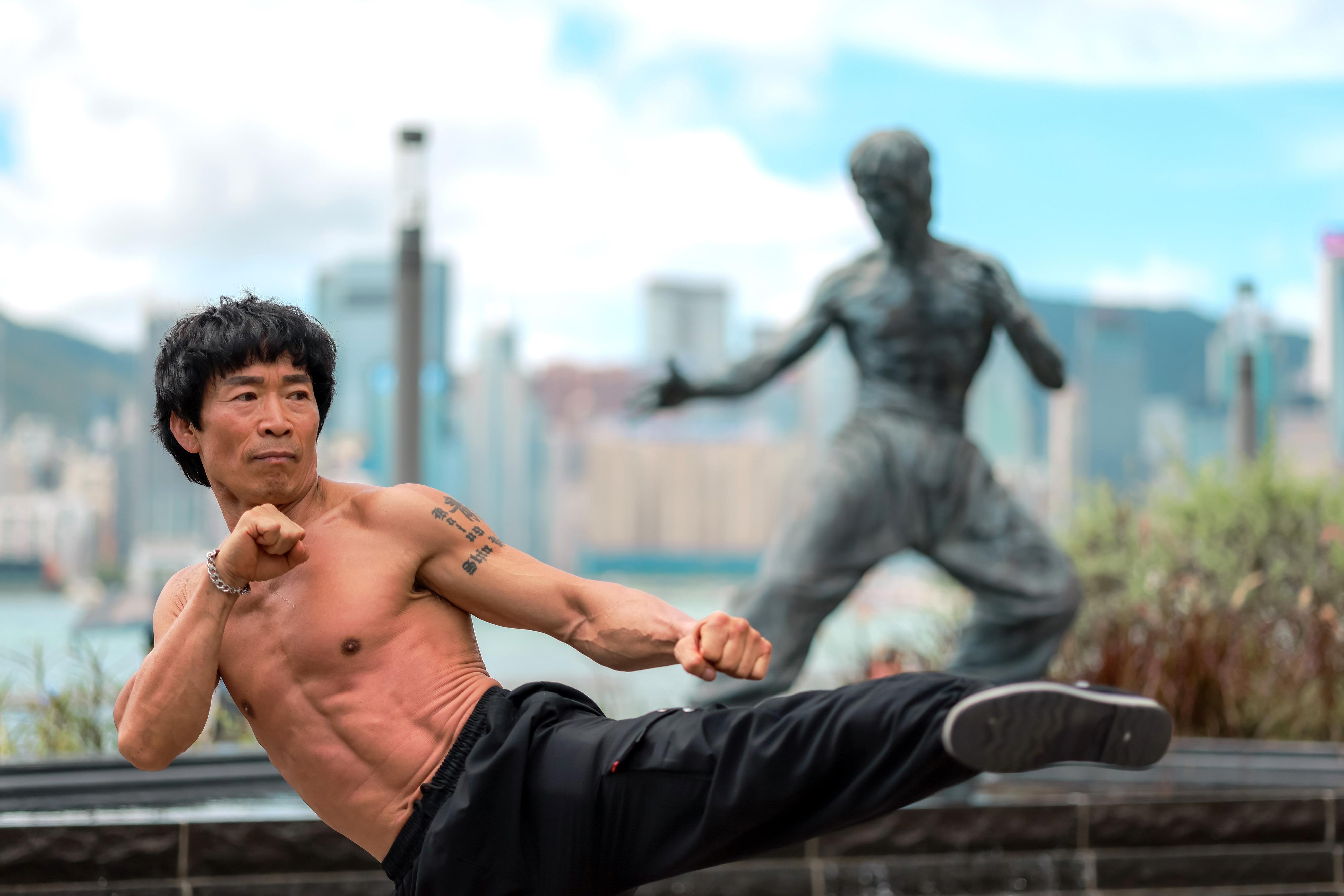 Fans from across the world pay tribute to Bruce Lee at his statue on the Avenue of Stars in Hong Kong. (ANDY CHONG / CHINA DAILY)
Fans from across the world pay tribute to Bruce Lee at his statue on the Avenue of Stars in Hong Kong. (ANDY CHONG / CHINA DAILY)
With Western mainstream art perpetuating stereotypes and marginalizing Chinese characters, Lee emerged as a game-changer by transforming the image of Chinese from underdogs with traditional braided hairstyles to powerful heroes, Zhang said.
Nima King, founder of Mindful Wing Chun, one of the largest kung fu schools in Hong Kong, said Lee not only shattered stereotypes about the Chinese, but of all marginalized ethnic groups.
King, who was born in Iran, moved to Australia when he was about 10. Growing up in a poor neighborhood in Sydney, and unable to speak English fluently, he could not fit in. He only made friends with other children from Asia, but this group was always given nicknames, teased and bullied by locals.
When he was 12, King and his friends watched Lee's films on video, becoming instantly drawn to him. Inspired by Lee's confidence, they felt more accepting of their identity.
Wong feels that labeling Lee only as a national hero is narrow-minded, as he embraced universal equality.
In the 1960s, Lee established a martial arts school in the United States, recruited followers from different nationalities, and changed the perception that martial arts could only be taught to adult Chinese males. In his films, he purposefully played characters from different ethnic backgrounds.
Asked during an interview whether he saw himself as Chinese or American, Lee said he thought of himself as a human being, and under the sky and heaven, there is but one family. Wong said Lee's thinking embodied an equality that transcended boundaries, countries and gender, elevating him to the status of a hero who surpassed the limitations of his time.
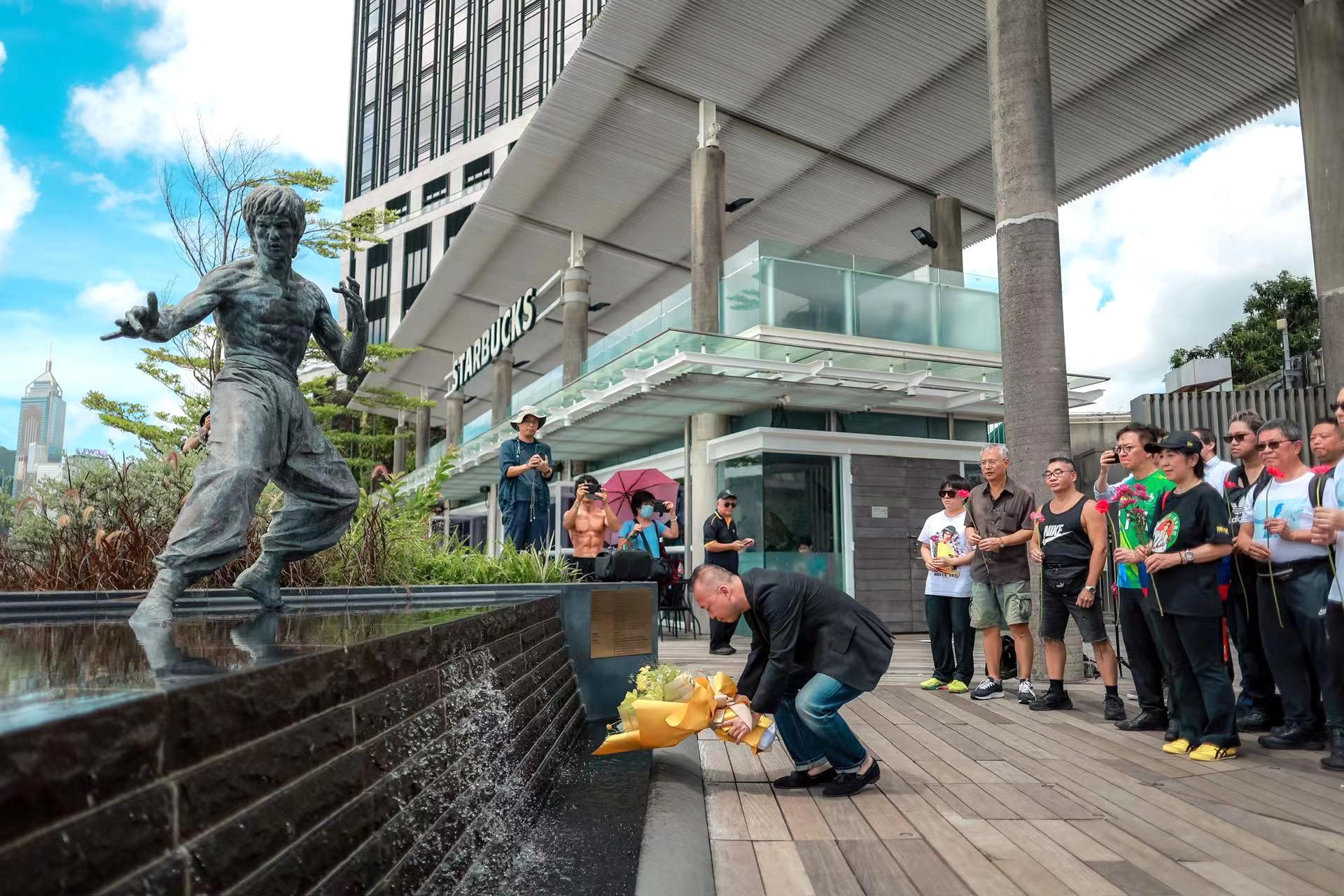 Fans from across the world pay tribute to Bruce Lee at his statue on the Avenue of Stars in Hong Kong. (ANDY CHONG / CHINA DAILY)
Fans from across the world pay tribute to Bruce Lee at his statue on the Avenue of Stars in Hong Kong. (ANDY CHONG / CHINA DAILY)
Philosophical concepts
Woo, the cultural critic, said another reason Lee is not forgotten is that he imbued martial arts with deep Chinese philosophical traditions. In the 1971 US television crime drama Longstreet, Lee spoke one of his best-known lines: "Be formless, shapeless, like water. Put water into a cup, it becomes the cup. Put water into a teapot, it becomes the teapot."
Woo said this line originates from Tao Te Ching, a classical Chinese text and foundational Taoism work written in about 400 BC by the sage Laozi. The work contains these words, "The supreme good is like water, which nourishes all things without trying to."
Such enduring philosophies give Lee a depth of thought that prevents him from becoming dated, Woo said.
In 1961, Lee enrolled at the University of Washington, where he took extensive philosophy courses and avidly read texts by Eastern and Western thinkers. He actively engaged with their ideas, writing many articles about them.
To mark the 50th anniversary of Lee's death, Zhang watched the 1973 film Enter the Dragon, which he viewed dozens of times as a child. This time, he was moved to tears.
"When I was a kid, I only saw the cool martial arts moves. Now, I can appreciate Lee's remarkable philosophical ideas," Zhang said.
Heritage plea
Wong said that in view of Lee's global appeal, Hong Kong should make better use of his cultural heritage. Many previous commemorations, such as the Tsim Sha Tsui statue, were initiated by the community, rather than the government, Wong said. He added that there is also no dedicated Bruce Lee museum or memorial in Hong Kong, and the city has long lacked a policy to preserve celebrity residences and culture.
Lee could be the trigger for the government to explore a comprehensive cultural heritage protection system, Wong suggested.
King said Hong Kong could develop more Lee attractions, while Nelsson proposed that Nov 27 be designated Bruce Lee Day for themed events in shops, cinemas, restaurants and other venues to attract visitors and business. Woo called for a Lee museum to be established to enrich tourism and culture.


